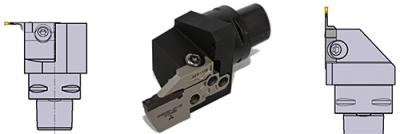
Mitsubishi Materials announces an expansion to the GY series with its GY-PSC type holders.
Technical Information:
- Standard PSC-type holders; quick-change toolholders for turning centers.
- PSC stands for Polygonal Shank Coupling, as defined by ISO26623-2.
- PSC directly integrated in the spindle increases stability and versatility in all grooving applications.
- Available in straight and 90° holder.
Applications to Target:
- Available in four sizes (C3-C4-C5-C6) to suit specific needs.
- Grooving applications where end users currently using PSC-type tooling.
Benefits:
- Uses all standard GY blades.
- Provides high basic stability and accuracy.
- Minimizes tool inventory.
Contact Details
Related Glossary Terms
- centers
centers
Cone-shaped pins that support a workpiece by one or two ends during machining. The centers fit into holes drilled in the workpiece ends. Centers that turn with the workpiece are called “live” centers; those that do not are called “dead” centers.
- grooving
grooving
Machining grooves and shallow channels. Example: grooving ball-bearing raceways. Typically performed by tools that are capable of light cuts at high feed rates. Imparts high-quality finish.
- shank
shank
Main body of a tool; the portion of a drill or similar end-held tool that fits into a collet, chuck or similar mounting device.
- turning
turning
Workpiece is held in a chuck, mounted on a face plate or secured between centers and rotated while a cutting tool, normally a single-point tool, is fed into it along its periphery or across its end or face. Takes the form of straight turning (cutting along the periphery of the workpiece); taper turning (creating a taper); step turning (turning different-size diameters on the same work); chamfering (beveling an edge or shoulder); facing (cutting on an end); turning threads (usually external but can be internal); roughing (high-volume metal removal); and finishing (final light cuts). Performed on lathes, turning centers, chucking machines, automatic screw machines and similar machines.
